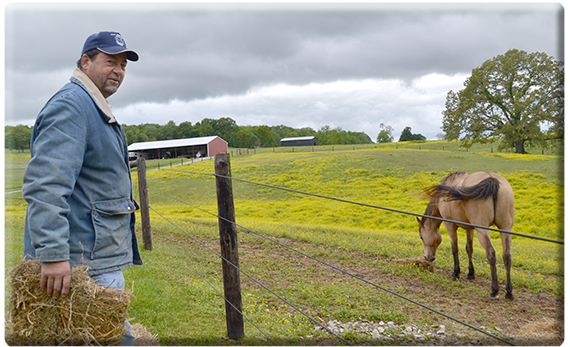Kentucky Ag News
Tim Coomer feeds horses on his Barren County farm. (NASS photo by Lisa M. Ferguson)
Lifelong farmer committed to helping other farmers
By LISA M. FERGUSON, National Agricultural Statistics Service
HISEVILLE, Ky. - What started as a need for a part-time job fueled by a lifelong dedication to farming turned into a passion for helping fellow farmers.
Tim Coomer, 56, of Hiseville began working on behalf of USDA National Agriculture Statistics Service (NASS) as an enumerator eight years ago, a job most outside of farming may have never heard about.
NASS conducts more than 400 surveys a year on farms all over the country. These surveys cover crop production and yields to farm equipment and finances, and everything in between. The people who conduct these surveys are called enumerators. They conduct surveys over the phone and in person, depending on how each farmer prefers to answer.
“If I’ve never surveyed a farmer before, I’ll always go out and meet them face to face,” said Coomer, a self-described big talker. “Most farmers don’t want to tell the government about their farm business, and it’s my job to help them understand why they should answer these surveys.”
According to Coomer, he tells reluctant farmers these surveys help them and other farmers.
“When our [Congressional representatives] don’t know anything about farming, they need numbers and statistics [to write farm bills and set agricultural policy],” Coomer said. “We need to know how many people are growing corn and how many people need help with their livestock, for example.”
Surveys and resulting data and statistics aren’t just helpful to passing farm bills; they are helpful to the entire agribusiness industry.
“All the implement companies want to know is there a trend going,” he said. “We have surveys that ask how many 100-plus horsepower tractors do you own, how many under-100 horsepower tractors do you own? The farm machinery companies use this [data] to decide what size tractors farmers are using and build to that need. Are they trending to a larger tractor now, or are they trending to a smaller tractor? What types of tractors farmers are using.”
The surveys and resulting data are useful in a variety of ways.
“The Kentucky Soybean Association wanted to respond to a decision by the Army Corps of Engineers in 2015,” said David Knopf, director of the NASS Eastern Mountain Regional Office in Kentucky. “The Corps wanted to increase the flow from the Barkley Dam [along the Cumberland River]. Farmers were concerned it would flood their crops along rivers and streams. With the survey data provided by farmers, NASS was able to estimate the number of cropland acres affected.”
A seed corn company asked him for yields by county.
“They intended to use the data to help them expand their varietal choices to farmers,” he said.
“One of our surveys a few years back asked if farmers had high-speed internet,” Coomer said. “They’d ask, well, why would that have any impact on farms? Farmers these days are buying so many inputs off the internet. There are lots of areas of our country that don’t have high-speed internet. We saw there was a need in a certain part of the state for [it], and indirectly from our survey, they got high-speed internet.”
Coomer is happy to continue working for NASS and having a hand in helping farmers succeed in their businesses, something he saw modeled by his parents growing up on an 82-acre dairy farm. As the youngest of 10, Coomer said they didn’t have much growing up, but he watched his dad work together with other farmers for the good of all.
Enumerator is just one of many hats Coomer wears in the Glasgow/Hiseville community. Besides running his own 212-acre farm, he manages a neighbor’s 672-acre farm and his late mother’s 20-acre farm, all that’s left of the farm where he grew up. He also helps out farmers as a member of the Farm Service Agency County Committee and drives a school bus for special needs children.
“The other night, my wife [Cherri] and I were finally sitting down eating dinner on the back porch at 9:30 at night,” he said. “It’d been a long, hard day, but I still looked at her and said, there’s no place I’d rather be.”
The next round of surveys local farmers are likely to see Coomer knocking on their doors to complete are the mid-year surveys, which start May 26 and run through June 10. The June Agriculture Survey and the June Area Survey determine crop production and supply levels, with questions ranging from total acreage farmed to amount of grains in storage to livestock on hand. Data from these surveys will be available June 30.















